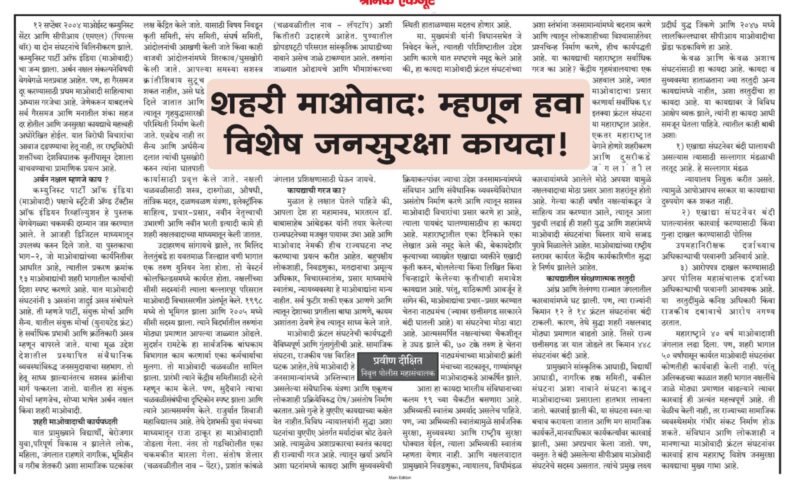Juvenile Justice:
Legal frameworks and Rehabilitation of children in conflict with law
Praveen Dixit
(www.praveendixit.com)
In following lines, it is proposed to underline the heinous crimes committed by juveniles. Thereafter, legal provisions to tackle this sensitive issue would be discussed. Efforts made and which need to be made to rehabilitate these juveniles would be explained with case studies. Every effort needs to be made by everyone to integrate these juveniles by making all out efforts to provide a chance to reform these youngsters not only for their wellbeing but also for the benefit of the society at large.
Memories of horrible incidents such as Nirbhaya episode in Delhi are never forgotten. Unfortunately, similarly terrible happenings are being reported from urban as well as rural areas and from all states without any exception. On few occasions, it is an incident of gang rape on helpless especially abled destitute, small girl belonging to scheduled cate or scheduled tribe, or rape on a girl after deceiving her with false identity. In some instances, the kids are not even able to narrate who committed the atrocities, but keep on complaining of severe body /stomach pain. Invariably, videos are made of such heinous happenings and if the victim is alive, she is constantly blackmailed and the heinous act is repeated several times. In most of these cases, the perpetrator is grandfather, step-father, cousin, relative or a person claiming to be close to the family. The offender may be working as security guard, housekeeping staff in housing society/school, cleaner, driver or conductor in school buses. If the victim refuses to marry, or there is apprehension that the identity of the accused may be disclosed, she is murdered ruthlessly and the body is disposed of beyond recognition in a remote place. Persons who commit these offences against children are dealt with under the provisions of The Protection of Children from Sexual Offences Act (POCSO). A section of these acts is committed by juveniles in the age group of 16-18. List of these offences committed by juveniles include robbery, snatching, gang rape, rape, robberies, murders, attempt to murder, thefts and many more. Recently they have been noticed indulging in cybercrimes including hoax calls and sending alarming fake e-mails threatening the school authorities and law enforcing agencies. Separately, hit and run incidents due to rash and drunk driving by juveniles from nouveau riche families in expensive cars resulting in death of innocent pedestrians or two-wheeler riders are being increasingly reported. In some left wing affected parts in Dandakaranya young persons are noticed joining militants.
Invariably, these incidents result in hue and cry and electronic and print media demand explanations from law enforcing authorities and seek explanation from the government for its effectiveness. Many a times, the public anger goes to the extent of demanding immediate hanging of the accused even though the suspect may be juvenile. National Crime Record Bureau (NCRB) which compiles data of these offences from all states reveals increasing number of incidents involving juveniles in the age group of 16 to 18 as suspects. As per the Juvenile Justice Act (JJA) 2015, a person below the age of 18 is considered as juvenile. The JJA further provides for minors in the age group 16 – 18 years to be treated as adults in the case of heinous crimes. Heinous crimes are those offences where punishment is more than seven years. Decision regarding an offence whether it is heinous or otherwise is taken by Juvenile Justice Board consisting of Judicial Magistrate First Class, and two other social workers out of which one is a woman. The object of the Act is to ensure the needs of children and protect their human rights fully. The second part deals with the care, protection and rehabilitation of children in need. Protection includes protection from harm to the life of a child, even from the parents and relatives. The children/victims should not be produced before multiple authorities and protect the interest of the victims of the sexual offence. While legal provisions to deter the offenders are adequate, effective implementation of the same by all agencies without getting influenced by extraneous sources is highly imperative.
Important factors which contribute in making children juvenile include absence of care and affection from parents because of divided family, large family and poverty resulting in absence of facilities. In view of urbanization, and easy availability of access to internet, children witness what they should not or get addicted to porn/violence videos. Many of them are also addicted to watch online games which encourage them to commit suicide or shooting as adventure. Today, social media platforms including Instagram, WhatsApp, Telegraph and many others are attracting young minds towards darknet which is full of spreading falsehoods, radicalising them to fundamentalism, and encouraging them to indulge in investing large amounts in bitcoins. There are several incidents when young girls have fallen prey to flirting and have been deceived with ulterior motives. Several countries including USA, Canada, Australia are contemplating seriously to make enactment where children below 14 would be prevented from having free access to internet. Australia has already enforced such enactment. Social platforms are likely to implement these reforms in these countries at the earliest. India also needs to make strident call in the same direction. There is adverse impact of advertisements and serials on TV/OTT and cinemas. After watching films with violence/ porn, children have made efforts to follow these in reality and ended up in remand homes. In red light areas, women force children to go outside at the time of business and these children fall in bad companies. Children become addicts to bad habits including drugs, drinks, smoking and other objectionable materials. Adolescent children try to impress their female friends and to satisfy various requirements particularly under the influence of drinks/drugs, do not hesitate to commit thefts/heinous offences. Either due to anger against their parents for petty reasons, or because of luring by someone including women to provide an opportunity to work as model, higher education, job or marriage, thousands of very young girls under the age of 18 have been noticed leaving their parents. Very few of these are traced and it is speculated that these might be ending in some brothels or might have been killed or transported to war zones including Syria, Afghanistan and other places.
Analysis of undertrial juveniles reveals from their statements that most of them were from deprived background. All of them had either dropped out from school or they were never regular to school. As a result of lack of education or no vocational skills, many of them were working as casual labourers. Due to dysfunctional families, these children had no mental or social support from their families. Family situation of undertrials was characterised by poverty, children forced into labour, inadequate parenting and their families were under continuous stress or there was sudden crisis like death, desertion etc. NCRB data underlines increasingly children from affluent families, having parents who do not pay attention to their upbringing, are indulging in heinous crimes, due to drug addiction. In addition, religious fanatics are noticed to be providing large funds and using these youth to deceive young girls and converting them under compulsion.
Though these children might have come in conflict with law, it is necessary that police officers remain sensitive to their plight. As Commissioner of Police in Nagpur, I ensured that these children are provided counselling by social workers. Those who were eligible to attend schools, were sent there. Others were provided vocational skills including driving. They turned out to be responsible persons and contributed to the income of their families. Similar initiatives are taken by many police officers. It is imperative that even after the change of unit-in-charge, these well minded initiatives need to be continued for a long time. It should be an effort of police officers to move the Juvenile Justice Board for action against parents of such children. Police officers need to strive to safeguard these juveniles from adult offenders who might be forcing such children to indulge in these heinous offences. Invariably, assistance should be taken from voluntary organisations, or child psychiatrists, child guidance clinics, social care workers, and probation officers to cure the cause behind such incidents. Police officers should also visit shelter homes/remand homes frequently to ensure adequate support and security is available at these places. Efforts should be made to detect such children at pre-delinquent situation and isolate destitute and neglected children. In a town, geographic areas which are breeding grounds of delinquency may be identified and these should be regularly patrolled. Initiatives including organising recreational programmes, sports tournaments, holiday camps, band displays create enthusiasm among one and all. While working as DGP, Maharashtra, we had initiated regular interaction with radicalised youth including young girls. Assistance was taken from seniors in their community and we persuaded them to realise the dangers of joining ISIS. In spite of these, there were few instances when these youth managed to leave for Syria and were caught there or got killed in war-zones.
Each unit should make an effort to have authentic data related to the children in conflict with the law, particularly their age and number. A Working Group called ‘the Commission for the Application of Alternative Measures’ under the auspices of UNICEF titled ‘Rights of Children in Conflict with the Law 2007’ has made recommendations for developing diversion programmes. These include:
- Juvenile offenders must admit to their crime;
- Juvenile offenders should not be placed in custody to participate in diversion programmes;
- Juvenile offenders are entitled to a court procedure if they or their guardians disagree with the diversion measures;
- Juvenile offenders may withdraw from the diversion process ay any time and opt for the formal court procedure.
The diversion programme includes seven components: victim-offender mediation, admonition, local community corrections councils, joint family meetings, circle trials, juvenile courts, and community service.
The UNICEF working group report argues that while crimes are often seen as offences against the state, they should also be viewed from the victim’s perspective, seeking reconciliation. It suggests allowing juveniles to make amends, the society can help them reintegrate faster, without a criminal record, which would help them avoid impediments in their future employment or social inclusion.
A high-level group constituted by NHRC in their meeting organised on 4 Feb2025 suggested following measures:
- Make information on proceedings involving Children in Conflict with the Law available on a portal, without revealing their identities;
- Establish a cadre of child protection officials in all States;
- Identify and delineate responsibilities within the child protection workforce, and fill vacant positions to strengthen the child care mechanism;
- Conduct a social audit of Child Care Institutions, ensuring adequate manpower, including counsellors;
- Encourage intuitional contribution to engage children in useful activities;
- Strengthen the Legal Aid Mechanism for Children in Conflict with Law;
- Increase ‘Community Service’ as a correctional measure for child offenders;
- Revamp rehabilitation and social reintegration programmes for Children in Conflict with Law;
- Introduce joint training for stakeholders involved in child welfare, focusing on the behavioural aspects of child offenders;
- Collate and publicise best practices for the welfare of child offenders across the country;
- Increase funding and staff recruitment for Child care Intuitions;
- Develop Standard Operating Procedures (SOPs) to streamline the process.
To conclude, holistic approach, combining enforcement with compassion and proactive intervention, can help rehabilitate at-risk youth and prevent them from becoming entangled in criminal activities.
*************** ************* ******************
Reference
NHRC’s Human Rights Newsletter Volume 32/Number 03/March 2025

